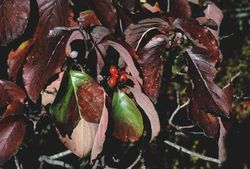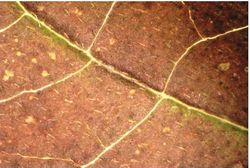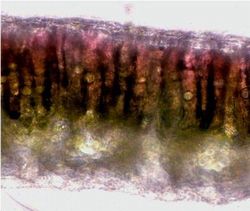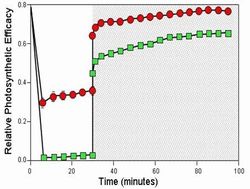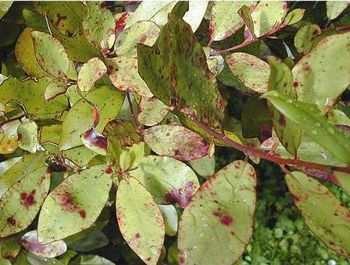You are here
The Physiological Explanation of Leaf Color Change
Anthocyanins have been noted as having significant importance as antioxidants both for nutritional and leaf tissue benefits and photoprotection for the leaf.
Anthocyanins as Antioxidants
In standard tests, anthocyanins, particularly the type found in leaves, are potent anti-oxidants. Such molecules neutralize the oxygen-rich molecules that are produced under stress or in aging, which attack the membranes of cells. Our awareness of these properties has led to some experiments with animal diets, showing that anthocyanins improve memory and brain tissue health. Publicity of these results has led to a dramatic increase in the popularity of blueberries among senior citizens, as the marketing boards for these fruits quickly publicized these results. For a time, blueberries moved quickly in the produce sections of supermarkets. Other fruits, as strawberries, also have high concentrations of anthocyanins.
The question for plants is whether these molecules could have similar functions in plant tissues, as in leaves during the autumn. One problem is that anthocyanins are accumulated in vacuoles, physically separate from the cytoplasm and chloroplasts where oxidative damage would most likely occur.
Nutritional Importance of Anthocyanins
Reversals of Age-Related Declines in Neuronal Signal Transduction, Cognitive, and Motor Behavioral Deficits with Blueberry, Spinach, or Strawberry Dietary Supplementation. James A. Joseph, Barbara Shukitt-Hale, Natalia A Denisova, Donna Bielinski, Antonio Martin, John J. McEwen, and Paula C. Bickford. The Journal of Neuroschience, September 15, 1999. 19(10):8114-8121
The article above documents a study recently published by scientists at a USDA Human nutrition laboratory at Tufts University, in which the anti-aging effects of blueberry extracts (loaded with the same anthocyanin common in leaves) added to the diets of rats was documented. Rats fed blueberries retained their memories of maze running better, and had more healthy brain tissue examined after death, than rats feed normal chow without the extracts. Blueberry supplements were more effective than strawberries or spinach.
Anthocyanins as Anti-oxidants in Leaf Tissue
Kevin Gould, at the University of Auckland in New England, has shown the anti-oxidant activity of anthocyanins in leaves of a local tree, the Horopito. Its leaves produce blotches of anthocyanins in otherwise green leaves. Damaging the leaf tissue with a needle produce a rush of reactive oxygen molecules, specifically hydrogen peroxide. Gould showed that the areas of the leaves with anthocyanins quickly neutralized the hydrogen peroxide. He showed this by introducing a fluorescent dye, whose blue fluorescence was suppressed by the hydrogen peroxide. The the four photographs prior to injury, after the injury, the anthocyanin- containing tissues had more fluorescence (and less hydrogen peroxide). An interesting result, but the real question is whether such activity in the vacuoles (where the hydrogen peroxide can diffuse) could protect the chloroplasts.
Photoprotection described in Red-Osier Dogwood
Evidence for the sun-screening protection of anthocyanins in aging leaves of red-osier dogwood was obtained by Taylor Field and colleagues. In this tree, the aging leaves vary dramatically in the production of anthocyanins, depending on exposure to sunlight. Leaves with anthocyanins had higher photosynthetic efficiencies, and also recovered to original function more rapidly, than leaves without anthocyanins. This effect was stronger when tested at lower temperatures, and was removed if the lower surface was exposed to the strong light (when the anthocyanins were not in the location to protect the chloroplasts. This is very good evidence for the protection by anthocyanins against sunlight in these leaves.
